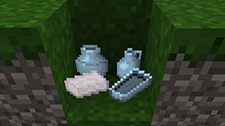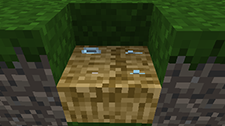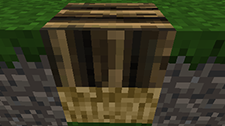石器時代的建議
歡迎來到 TFC+!
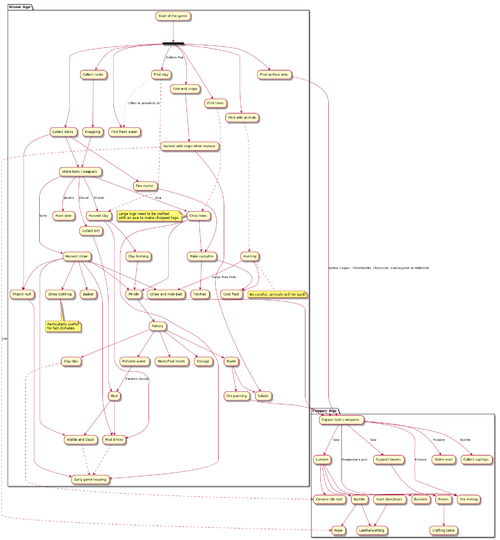
Terrafirmacraft+為Minecraft的生存模式為基底重新架構,並使其更加擬真的模組,適合熟知原始Minecraft的設定,且想要其複雜程度和細節更加擬真的熟練玩家。
此導引主要是幫助新入玩家,解說原版Minecraft與TFC+的不同之處,而對TerraFirmaCraft有經驗的玩家,可以參照與TFC不同之處(英:Differences from TFC)的頁面.若是有問題可以造訪ttps://discord.gg/GhqaFgQ Discord或ttps://reddit.com/r/TFCPlus Subreddit尋求幫助。
雖然Terrafirmacraft+有些許翻譯,但仍未完成。如果想要想幫忙翻譯,請參考翻譯 (英: Translation)頁面。
這導引主要是已安裝好Terrafirmacraft+為前提,尚未安裝好的人請參照安裝(英:Installation)頁面。
關於最初開始
HUD介面與統計數據
當你開始一個新的世界,你會注意到與常玩的原版Minecraft的HUD介面完全不同,此章節為解說TFC+的HUD介面。
生命值
![]()
第一個與原始Minecraft不同的值就是生命值。TFC+以紅色的條棒值取代愛心(HP)做為生命值,生命值最初有1000的值,但會受到健康狀態和各種因素而變化。生命值會於飽腹值25%以上時隨時間慢慢回復,就算吃滿飢餓值也不會快速的回滿生命值。泡溫泉可快速回復生命值或使用殺菌繃帶(英:sterile bandages)來回復100生命值。
此外,玩家也會受傷(英:wounded),和受到各種狀態效果。受到一次生命值20%或高於其值的傷害就會受傷。骨折會使移動速度變慢、傷口不處理會使生命值慢慢減少;受到破碎的傷害或落下傷害會骨折、受到貫通或切斷的傷害會造成傷口。傷口的治療可參考藥物(英:medicine)的頁面。
飢餓值
![]()
原版Minecraft飢餓值的骨頭肉替換成綠色條棒。
且飢餓值系統也不同,TFC+的飢餓值回復以食物的重量為主(不論食物種類,同樣的量不影響回復數值的多寡),TFC使用自訂的重量單位oz,此單位與現實或其他遊戲的單位沒有任何關聯,若怕搞混可用「幾個的量」或「幾口的量」來分辨。TFC+的食物堆疊重量最高為160oz。
而就算玩家沒有任何動作或移動,飢餓值仍然會隨天數的增加而減少。當玩家飢餓值減少於一定的數值,會陷於「虛弱」或「挖掘疲勞」等負面狀態;當玩家飢餓值見底時,將開始感覺到飢餓的痛苦,最終死去。
口渴值
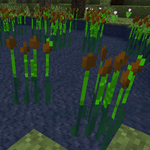
![]()
TFC+導入會感到「口渴」的概念,並增加了口渴值的藍色條棒來表示。口渴值會隨時間增加而慢慢減少,並且在一定數值下會陷於「虛弱」或「緩速」的負面效果;口渴值也會因日曬或天氣冷熱的外在因素而影響其減少的速度。口渴值見底後若未補充水分不久後就會死於中暑。與飢餓值相同的就算玩家沒有動作或移動依然會隨時間慢慢減少。玩家只能飲用有淡水水域的水,所以要存活在這世界重要的是找尋有淡水的地方。可以喝水的淡水水域有長著鹹水(海水)水域所沒有的香蒲或睡蓮,可以藉此來分辨水域的不同。
對淡水水域的方塊底部![]() Right Click就可開始喝水,並可持續壓住
Right Click就可開始喝水,並可持續壓住![]() Right Click直到口渴值完全回復。
(現在有著在原世界登出開啟別的世界時手握著物品狀態下在切換後無物品後無法喝水的BUG。在別的世界改成手無持物下重新啟動Minecraft即可修復)
Right Click直到口渴值完全回復。
(現在有著在原世界登出開啟別的世界時手握著物品狀態下在切換後無物品後無法喝水的BUG。在別的世界改成手無持物下重新啟動Minecraft即可修復)
在遊戲初期為了能夠長時間和長距離的冒險,可把製作出一個能裝淡水的水壺做為優先目標
經驗值
經驗值系統變更為生活經驗的效果,提升等級會增加玩家的最大生命值、口渴值、和酒(英:alcohol)的耐受度。可承受更大的傷害、更長時間不需喝水來冒險、以及能喝下更多的酒後減少受到負面效果的機會。
與原版不同,沒有賦魔或工具修理來消耗經驗值,所以只有死亡才會減少經驗值。
體溫

體溫會顯示在畫面右下的溫度計,溫度計綠色的部分是玩家最舒適的範圍。玩家的體溫會受到季節或地區的氣候,以及特定的方塊的周遭影響。當玩家感覺太熱或是太冷時,會受到一些負面效果比如說「緩速」或「挖掘疲勞」,甚至會沒辦法在茅草床上睡著。而藉由出汗讓身體變涼以及燃燒卡路里來讓身體保暖的原理,太熱和太冷也會增加飢餓值或口渴值的減少速度。
體溫主要藉穿著衣服(英:Clothing)來調整,屋簷(英:Roofs)來提供室溫的保護,以及在樹蔭、陰影、山洞中躲避日曬或氣溫,保護玩家避免受到自然因素的影響。
物品欄
物品欄在TFC+內有四種顯示可選,有如同原版的「物品欄」來存放撿拾的物品或製作的工具;「技術」顯示玩家目前各種的技術等級;「日曆」顯示年分、時間、季節、以及天數和星期幾;「健康」顯示玩家對五種食物營養素的攝取量(營養不均會影響生命值最大值),以及目前有無傷勢。
與原版不同,所有可製作的物品均在物品欄內的工具欄製作,玩家初始有2x2的工具欄,可藉製作工具台後解鎖為3x3的工具欄,而再製作出來的工具台放置後也無法用來製作物品,直到死亡後才會變回2x2的工具欄(工具台需再重新製作來解鎖)
The First Day: Tools, Light, and Clothing
The goal for the first day is to prepare for the night and for the player's long-term survival. It is important to look around you, and to see what resources are available to you. If you see yourself in a plain, with grass, shrubs, and boulders stretching to the horizon, you might be able to find metal nuggets and animals to hunt quite easily. If you see yourself on a coast of an ocean, seaweed and fresh water is easy to find. If you find yourself in the deep rain forest, clay, fresh water, and wood are plentiful.
What You Can't Do
You might notice that you can't punch trees to get wood. This is because the tech-tree in Terrafirmacraft+ is completely different from that of vanilla Minecraft. This means that your first tools will be made from stone. There is no such thing as wooden tools in Terrafirmacraft+, and wasting your time to punch down a tree will yield you absolutely nothing. You cannot make planks, and thus a crafting table in Terrafirmacraft+ - you will need a saw, which can only be made from metals.
There is no such thing as a Wooden or Stone pickaxe in Terrafirmacraft. In the early game, you do not mine stone for ore. Instead, there are other ways to acquire metal ore and tools, without needing a pickaxe. This will be how you will make a pickaxe to mine more ore.
Punching dirt is not recommended, as even if you manage to break a block, it, in addition to sand, gravel, stone and cobblestone, are affected by gravity in TerraFirmaCraft+. Unlike in Vanilla Minecraft, gravity-affected blocks are able to fall sideways, in addition to falling straight down. You will not be able to create a house out of these blocks.
Players used to vanilla Minecraft might wonder how one stores items in Terrafirmacraft+. Because planks as they are in vanilla are locked behind metal, early-game alternatives to the chest such as the Straw Basket, Large Vessel, Ceramic Vessel, and Raw Hide Bag are available.
Sprinting everywhere is not economical in TFC+ - your hunger and thirst declines much quicker. Instead, the Wooden Staff can be used for a speed bonus that is half that of sprinting. The Wooden Staff will be discussed later in this article.
Torches in TFC+ will light flammable blocks on fire. Before using a torch, it is recommended to clear the area of any flammable blocks, including grass, undergrowth, and fallen leaves. To light up your shelter, use a Firepit, which will be discussed later in this article. Later, you will be able to craft a Candle, which is a safe source of light.
Sticks and Stones
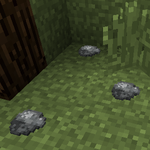
In Terrafirmacraft+, the first thing you should do, instead of punching trees, is to gather the rocks laying scattered all across the ground. 64 rocks will last you through the first few days of gameplay.
Occasionally, you might find some ore nuggets. Be sure to take note of the location, as these are important later.
You will also want to find some sticks. Sticks can be found occasionally on the ground under trees and on shores, and can also be obtained by breaking leaf litter. Sticks can also be obtained by breaking undergrowth and shrubs with an axe.
Knapping
Knapping is the process of using two rocks to create heads for stone tools. ![]() Right Click while holding a stack of two or more rocks to open the knapping interface. The process of knapping will produce stone flakes, which are also used in crafting.
Right Click while holding a stack of two or more rocks to open the knapping interface. The process of knapping will produce stone flakes, which are also used in crafting.
The knapping interface is a 5x5 grid. Clicking on a square of the grid will break off that piece of stone. Be careful where you click - if you make a mistake, you cannot undo it and you will have to start again. If you successfully create a specific shape, a tool head will appear to the right which can then be attached to a stick or a bone in the crafting grid to create a stone tool. While knapping, Stone Flakes might be produced, which can be used to craft arrows later on.
Tip: Some of the tools can be knapped out differently than the below forms, feel free to experiment.
Tip: Completed stone tools do not stack, but tool heads will stack up to 32. At night when you are hiding from monsters, you can knap a handful of each tool head to keep in your inventory. Then during the day when your tool breaks, you can quickly combine another head with a stick or bone for a new tool.
If you successfully create a specific shape, a tool head will appear to the right which can then be attached to a stick or a bone in the crafting grid to create a stone tool.
|
|
|
|
Wood
Wood is gathered by chopping down trees with an axe. If you break the bottom log of the tree with an axe, it will break the entire tree into logs and sticks. If your axe does not have enough durability to chop down the entire tree, only the top of the tree will be chopped, and the axe will break.
Trees come in two sizes: the normal tree that populates forests and grasslands, which drop regular-sized logs, and the rarer large trees which drop large logs. Large logs can be hewed into regular-sized logs; however, it is not recommended you do this, as large logs are comparatively rare, and can be used for building.
Logs can be stored in a log pile by ⇧ Shift + ![]() Right Click onto the ground. Only regular-sized logs can be used to start a log pile, however, once the log pile is created, it can be used to store large logs, as well.
Right Click onto the ground. Only regular-sized logs can be used to start a log pile, however, once the log pile is created, it can be used to store large logs, as well.
Logs can be crafted into poles with a knife, and poles can be snapped in half to make sticks.
Logs can be right clicked with a knife to receive Resin; this can be used to craft various items, such as the Wooden Staff, and the Primitive Bandage. The Wooden Staff is made from Resin combined with a Pole, and gives the player a 15% speed bonus while walking when it is held. This speed bonus is half of the sprinting speed. Because sprinting in Terrafirmacraft+ causes the player to become hungry and thirsty faster, it is recommended to use the Wooden Staff instead of sprinting whenever possible. The Primitive Bandage is used when the player gets wounded; see the Wounds and Medicine section.
Weapons
Weapons are important in order to hunt wild animals and defend yourself from monsters at night. Early game weapons, like tools, can be knapped from stone, or, in the case of the Wooden Spear, shaped from a pole. In Terrafirmacraft+, there are three types of damage: Slashing, Piercing, and Crushing. Slashing is effective against Endermen and Zombies. Piercing damage is effective against Bears, Creepers, Endermen, and Wolves, and Crushing is effective against Endermen and Skeletons. Axes deal Slashing damage, Javelins and Spears deal Piercing damage, and Hammers deal Crushing damage. The Knife has two modes, Stabbing and Slashing, which deal Piercing and Slashing damage respectively.
|
|
|
Javelin heads need to be crafted with a Pole in order to create the full Javelin, while Stone Hammers, like tools, need to be crafted with a Stick or a Bone.
Wooden Spears are an weaker version of the Stone Javelin. They can be crafted from a pole and a knife.
Wooden Spears and Javelins will automatically refill from your inventory after one is thrown.
Hunting and Foraging
Finding a source of food and water is important for your long term survival. Only fresh water can be drunk; the process of finding and drinking fresh water is described in the Thirst section.
Seaweed
A good source of early-game food - if you are near the shore - is seaweed. Seaweed can be harvested using ![]() Right Click on the block below the seaweed while holding a knife. Once you have a few pieces of seaweed, you can stack them together by hovering over one piece of seaweed and pressing S to stack the seaweed together. Alternatively, the seaweed can be crafted together in the Inventory grid to stack them.
Right Click on the block below the seaweed while holding a knife. Once you have a few pieces of seaweed, you can stack them together by hovering over one piece of seaweed and pressing S to stack the seaweed together. Alternatively, the seaweed can be crafted together in the Inventory grid to stack them.
Meat
If you cannot locate a shore, the next best source of food is meat. Animals can be found clustered in groups around the world. Do not attack them right away! In Terrafirmacraft+, animals are neutral mobs, and will attack the player if the player attacks them. As animals are also much harder to kill than in Vanilla, you should prepare yourself before you attack an animal.
Note: Do not underestimate animals! They have large amounts of knockback and damage. They are not harmless, like in Vanilla!
Stand away some distance from the animal, and hold ![]() Right Click to prepare your spear or javelin. Do not attack the animal directly with the javelin! Hitting an animal with a javelin deals far less damage than throwing it. Release in order to throw it. Be careful, as the animal will now try to attack you. Throw multiple spears in rapid succession, until the animal dies. In Terrafirmacraft+, animals drop as much meat as their body weight. This means that large animals will drop quite a lot of meat. You do not have to worry about picking up all the meat, as a few stacks will suffice for a few days. Be sure to pick up the Raw Hide, too, as it is very useful later.
Right Click to prepare your spear or javelin. Do not attack the animal directly with the javelin! Hitting an animal with a javelin deals far less damage than throwing it. Release in order to throw it. Be careful, as the animal will now try to attack you. Throw multiple spears in rapid succession, until the animal dies. In Terrafirmacraft+, animals drop as much meat as their body weight. This means that large animals will drop quite a lot of meat. You do not have to worry about picking up all the meat, as a few stacks will suffice for a few days. Be sure to pick up the Raw Hide, too, as it is very useful later.
If you are wounded, jump to the Wounds and Medicine section, then come back.
Foraging
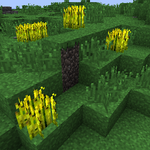
Crops spawn randomly in the wild between the seasons of spring and late summer, and have a chance to regenerate during those seasons every year. Breaking a wild crop will give only seeds if it isn't fully mature, so you should wait until it has reached the last stage of growth before harvesting if you want food. If you can find mature crops, they will serve as a good source of food.
Fruit trees and Berry Bushes can also be found in the wild. To harvest the fruit from a fruit tree or berry bush, ![]() Right Click on their leaves. Berry bushes can be picked up by breaking them, and placed elsewhere later on.
Right Click on their leaves. Berry bushes can be picked up by breaking them, and placed elsewhere later on.
These long-term food sources may be hard to find. Players are reminded that finding crops in Terrafirmacraft+ involves exploring a large area, much larger than required in vanilla - typically, the climate only changes if you travel about 1000 blocks away from an area. This may be confusing to players that are used to Vanilla, because Vanilla uses Biomes to determine the generation of resources, while Terrafirmacraft+ instead uses a climate system. Imagine that you are trying to find a different biome in Vanilla - if you cannot find these food sources, simply travel further, and rely on what you have to feed yourself while exploring. Despite this, it is completely possible to find these sources, and to sustain yourself for a long time.
Grain crops must be refined with a knife to make them into their edible version. This will also return straw.
In a pinch, mushrooms found in leaf litter can be cut with a knife to make them edible. Only brown mushrooms are safe to eat raw; red mushrooms must first be cooked.
Note: Do not break the leaves of the fruit trees! They take a long time to regrow.
Seeds can later be planted for a long-term food source.
If you have many stacks of food, you can stack them together. This can be done either by crafting the stacks of items together, or by hovering over one stack of food and pressing S (for "stack"). Food will eventually decay, and will have to be preserved for them to last longer. Decay can be cut off of food with a knife automatically by pressing D while your inventory is open, or by crafting the decayed food with the knife. Preservation methods will be discussed later on in this article.
Beekeeping
- Main article: Beekeeping
Wild Beehives occasionally generate on trees. Beehives are a source of Honeycombs, which are useful to make honey, which is a source of food, and also as a source of Wax for Candles. The player may also choose to make their own artificial beehives to gather more honey.
Players cannot open beehives directly. The bees will sting the player if they attempt to open or break the beehive. To calm the bees so that opening the beehive is possible, the player must light a Firepit underneath the beehive to calm the bees and allow the beehive to be opened. Wild Beehives have a Fertile Honeycomb in them; this can be used to create an artificial beehive, or can be cut to gather the honey inside. Once the Fertile Honeycomb is removed from the Wild Beehive, the beehive will collapse and drop some Empty Honeycombs; this can later be melted for Wax, which is an essential component of Candles.
The making of bowls so that you can remove the honey from the honeycomb is discussed later in this article, and the process of creating an artificial hive can be found at the Beekeeping article.
Firepit
- Main article: Firepit
At the end of the first day, you will probably want to create a firepit to make some torches, and cook any meat you've collected so you can eat it. You'll need at least five sticks, some logs to use as fuel, and optionally a piece of straw.
First, you'll need to put two sticks in the grafting grid in a diagonal pattern to make a firestarter.
Once you have a firestarter, throw (Default: Q) three sticks on the ground or other non-flammable block. Make sure they are all stacked on the same block, preferably in the middle. It's possible that your first few tries to light the firepit will not work. You can optionally toss an extra piece of straw in order to make the process faster. Once the firepit appears, drop some logs on to it to quickly add fuel. You can ![]() Right Click on the firepit as long as you aren't holding a firestarter or flint & steel to open its interface. The firestarter can later be upgraded by crafting it with a Bow to produce a Bow Drill, which has a higher effectiveness and durability.
Right Click on the firepit as long as you aren't holding a firestarter or flint & steel to open its interface. The firestarter can later be upgraded by crafting it with a Bow to produce a Bow Drill, which has a higher effectiveness and durability.
If the firepit goes out, you'll need to add some fuel and then ![]() Right Click on it with a firestarter to relight it. Relighting is instant.
Right Click on it with a firestarter to relight it. Relighting is instant.
Once you have a firepit, it is recommended that you make some torches. Torches can be easily lit by pressing ![]() Right Click on a lit Firepit while holding an unlit torch. A placed lit Torch can be used to light unlit torches in the same way.
Right Click on a lit Firepit while holding an unlit torch. A placed lit Torch can be used to light unlit torches in the same way.
![]() Right Click on a lit torch or lit firepit, or place and
Right Click on a lit torch or lit firepit, or place and ![]() Right Click with a firestarter or flint and steel to light the torch.
Right Click with a firestarter or flint and steel to light the torch.
Warning: Torches can set nearby flammable blocks on fire! They are not meant for indoor use if your shelter is made of wood or straw. Clear the nearby area of grass, undergrowth, trees, and leaves before placing down a torch. Use a Firepit instead to light up your shelter, and later upgrade to Candles.
Straw
Breaking tall grass with a knife yields straw. Straw is highly useful in the early game, as it can be made into shelter, storage, clothing, bandages, splints, and bedding.
Straw can be woven using the same knapping interface as rocks. To begin weaving straw, ![]() Right Click while holding at least five pieces of straw.
Right Click while holding at least five pieces of straw.
|
The Basket has 9 slots of inventory space. It will drop its items when it is broken. |
The Straw Cloak provides a moderate amount of cold protection. It is useful if you have spawned in a cold environment. |
The Straw Hat provides a slight amount of heat protection, and protects you from the heat of the sun. | |||||||||||||||||||||||||||||||||||||||||||||||||||||||||||||||||||||||||||||||||
|
The Grass Shirt provides a slight amount of heat protection. |
The Grass Skirt provides a slight amount of heat protection. |
The Grass Sandals give a small speed bonus when on sand. |
Straw can also be crafted into Straw Blocks, which are useful for building huts to hide from mobs at night.
Note: Players and mobs are able to move through straw blocks. You cannot use straw blocks to pillar up to safety, as you will simply fall through the block when you try to jump on it. Hostile mobs will not be able to spot you if you are already hiding in a straw block enclosure, but they are able to follow you through straw blocks if they have been aggro'd while you were outside of the straw block.

If you have a piece of Large Raw Hide, you can craft a Straw and Hide bed by placing two Straw Blocks adjacent to each other. Then, ![]() Right Click with the piece of Large Raw Hide in your hand while facing the straw blocks straight-on in order to create a Straw and Hide Bed. This can be used to skip the night. Be aware, through, that you might need to craft clothing in order to sleep in a Straw and Hide Bed, as it will be too uncomfortable to sleep in if you are too hot or too cold.
Right Click with the piece of Large Raw Hide in your hand while facing the straw blocks straight-on in order to create a Straw and Hide Bed. This can be used to skip the night. Be aware, through, that you might need to craft clothing in order to sleep in a Straw and Hide Bed, as it will be too uncomfortable to sleep in if you are too hot or too cold.
If you made it this far, congratulations. You have survived your first day in Terrafirmacraft+, and have the means to survive at night. Do take note that in TFC+, mob spawns are heavily increased, and it is not a good idea to be wandering around at night. It is recommended to stay near a firepit, and perhaps continue with Pottery, if you have a clay source nearby. You may now explore more long-term possibilities for survival, and progress towards the Copper Age.
Beyond The First Day
The days beyond the first day are focused on securing more tools for survival. You will also work your way towards leaving the Stone Age and entering the Copper Age, which will unlock more possibilities for long term survival.
Environment and Seasons
Instead of vanilla biomes, in Terrafirmacraft+ there is a climate system. Rainfall, elevation, distance from the equator, and time of year determine what types of animals, plants, and terrain will generate in an area. Players will always spawn in the northern half of the map, during the season of early summer.
Terrafirmacraft+ adds the four seasons to Minecraft. The seasons affect the ambient temperature, the behavior of animals, and the timing of sunrise and sunset. In winter, unharvested crops will turn back into seeds, trees will lose their leaves, and new saplings that are not evergreen will not grow. In spring, long grass, flowers, rocks, and saplings will regenerate. In summer, crops will respawn randomly over the world, and can be harvested for seeds. In autumn, trees will turn brown, and the ambient temperature will begin to fall. The player must prepare for the four seasons adequately, and the unique challenges that each provide, such as the heat of summer, especially if the player is in a tropical region, and preparing the cold of winter, by building shelter and sewing clothes.
Areas around the equator tend to be wetter and hotter, and eventually becomes tropical, then temperate, then boreal, and finally polar at 27000 blocks North or South.
Rivers generate along biome borders, and are much larger than Vanilla. Their riverbeds will contain clay deposits that will be useful if one spawns in a climate too dry to spawn clay.
Terrafirmacraft+ also introduces the idea of Regions. Instead of biomes, Regions are what determines what trees, plants, and animals spawns in an area. For example, Black-Eyed Peas can only be found in Africa. Along the edges of regions, huge mountain ranges will generate.
Pottery
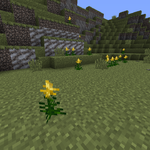
Clay generates near ponds and in riverbeds across the world. It can be distinguished from dirt from a distance by the existence of yellow Goldenrod flowers which only grow on clay. It can be dug with a shovel to obtain clay balls, which can then be shaped into clay items, and fired to make Pottery. Pottery is an important step of progression in Terrafirmacraft+, as it allows fresh water to be transported, Mud to be made, and to create vessels and Gold Pans.
Clay, like Straw and Rocks, has a knapping interface for forming clay items. Hold five clay balls in your hand, and ![]() Right Click to access it.
Right Click to access it.
The Ceramic Jug allows you to pick up water using |
The Ceramic Vessel has four slots of inventory space for small items. It is essential for progression to the Copper Age. Ceramic Vessels can only hold grains. |
The Ceramic Bucket is necessary for picking up water to create Mud. | |||||||||||||||||||||||||||||||||||||||||||||||||||||||||||||||||||||||||||||||||||
|
Ceramic Bowls can be used for the creation of Salads, or to craft a Gold Pan. |
Large Vessels are an early game Barrel. Large Vessels can contain 9 items, as well as liquids, and can be carried on the player's back. They can be mounted on a Firepit in order to melt items, such as Empty Honeycombs into Wax. Large Vessels are also a part of the Still. |
After you have made a clay item, it must be fired before it can be used. To do this, you will need to make a Pit Kiln.
Pit Kiln
To make a Pit Kiln, dig a pit in the ground, and ⇧ Shift + ![]() Right Click the items to be fired into the pit. Then, add eight straw, then eight logs, by right clicking on the pottery.
Right Click the items to be fired into the pit. Then, add eight straw, then eight logs, by right clicking on the pottery.
- The pit kiln will not work as pictured below. These images are in cross section, with the required surrounding blocks removed for visibility.
-
⇧ Shift+
 Right Click the items into the pit
Right Click the items into the pit -
Pit kiln with added straw
-
Complete pit kiln
The Pit Kiln can now be lit with either a Firestarter or a dropped torch. Lighting a pit kiln using a torch will produce sparks that might burn flammable blocks nearby, so be careful where you build your pit kilns.
The Pit Kiln will take eight hours to complete. Once it is complete, you can ⇧ Shift + ![]() Right Click the items out of the pit kiln. The items can now be used.
Right Click the items out of the pit kiln. The items can now be used.
Sewing
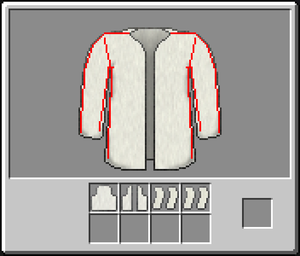
Sewing can be used to craft Raw Hide Bags for carrying around more items, and to create more advanced clothing from materials like Fur.
To begin sewing, one needs a Bone Needle. Bone Needles can be made by repeatedly punching a Stone Block with a bone in your hand. It is recommended to have several bones, as not every bone will drop a Bone Needle. Once a Bone Needle is produced, it can be threaded with a thread, such as Sinew (from killing animals).
Leather and the various cloths can be cut into clothing pieces. ![]() Right Click with the clothing pieces with a threaded bone needle in the inventory to show the sewing GUI. Place the necessary clothing pieces into the slots. An image of the clothing will appear. Use the Threaded Bone Needle to trace the thread around the red lines in the image. Using
Right Click with the clothing pieces with a threaded bone needle in the inventory to show the sewing GUI. Place the necessary clothing pieces into the slots. An image of the clothing will appear. Use the Threaded Bone Needle to trace the thread around the red lines in the image. Using ![]() Right Click with a knife on the image will remove a section of thread. Once the red lines on the image is completely traced correctly, and all incorrect parts of the tracing are removed, the completed clothing will appear in the output slot.
Right Click with a knife on the image will remove a section of thread. Once the red lines on the image is completely traced correctly, and all incorrect parts of the tracing are removed, the completed clothing will appear in the output slot.
A Raw Hide Bag is crafted with two Hide Bag Pieces, which can be cut from Raw Hide.
Wounds and Medicine
In the course of playing, you may get wounded. These are represented by the Cut, Bleeding, Wound, and Fracture status effects. These wounds can be mitigated through the use of medicine. There are several types of medicines. Cuts and Wounds can be healed with bandages but will eventually heal on their own, while Fractures require splints to heal, and will never heal without them. Getting hurt while wounded might make the wounds you already have more severe.
To craft some crude bandages, you will need some straw and some tree resin. Once you've crafted the bandages, hold them in your hand and hold right click to start applying them. A single crude bandage will set the time remaining on the wound to 30 seconds, and is enough to treat minor wounds and bleeding.
To craft a splint, you need a stick and a piece of any string. A early-game version of string, Straw Cordage, can be made by weaving straw. Alternatively, any kind of string will do, even sinew from an animal. Once you've crafted a splint, hold it in your hand and hold right click to start splinting your fracture. A single splint should be enough for minor fractures, and will remove the movement penalty from the fracture itself while allowing the timer on that fracture to tick down. A fracture's movement speed reduction can also be mitigated through the use of a wooden staff, which can be crafted with a pole and a piece of resin. Holding the staff while walking will allow you to walk normally, ignoring the movement speed reduction as long as the staff is held.
You can check if a wound has been healed by opening your inventory and looking at the status effect panel: if it displays a lowercase "t" near the wound, it means the wound has been treated and is healing. In case your wounds are more severe and a single bandage or splint is not enough, you can just keep applying bandages or splints as needed. Note that each medical item will only heal one wound, so if you had a Wound and a Cut at the same time you'd need to use at least two bandages.
Storage
You may now have gathered too many items to carry around in your inventory. Unlike Vanilla, in TFC+, chests are locked behind metal saws. In the early game, one must resort to alternatives.
One of the easiest to make storage items is the Straw Basket. It can contain 9 slots of solid items, but cannot contain liquids. Large Ceramic Vessels and Ceramic Vessels can be crafted from Clay. The Large Ceramic Vessel can contain liquids or 9 slots of solid items. Ceramic Vessels are portable, and can contain four slots of small items, meaning items that are too big for it will not fit. The Raw Hide Bag can contain six slots of items.
Shelter
By now, you will have established your tools, have some food, and have portable fresh water to explore the world. You will now want to establish your shelter so you have somewhere to hide at night.
Choosing a Site
You will want to equip yourself with a few jugs of water and some Food. Explore the world for a suitable site. The best sites have certain traits that you may want to look out for.
Stone and Metal
| Copper Ore | ||||
|---|---|---|---|---|
On the surface, ore nuggets will spawn. These indicate the existence of a ore vein underground (up to 35 blocks deep). Settling close to these ore nuggets will allow easy access to metal to mine later on.
Several stone types spawn materials that are more useful. One consideration is Flux Stone, which turn into Flux. Flux is necessary for binding metal ingots together while smithing. Any material made of Flux Stone, such as Gravel, Sand, or Rock, can be made into Flux. Thus, if a beach spawns Dolomite sand, you will be able to make that into Flux Stone.
| Flux Stone | |||
|---|---|---|---|
If you do not settle near flux stone, you will need to gather seashells in order to make flux. This might be time consuming.
Trees
Wood is important for charcoal and as building and crafting material. Proximity to trees is almost necessary. Not settling near trees also means you might be in a dry area, which might not spawn clay.
Clay
Clay is important to create molds for tools and ingots, as well as Ceramic Roof Tiles. An area not having clay also means you are in a dry area, and there likely will not be easily accessible clay anywhere nearby.
Water
In Terrafirmacraft+, one cannot place water source blocks unless they have a Red Steel Bucket. This makes access to both fresh water and sea water important. Fresh water can be drunk and is important in certain crafting recipes. Seawater can be made into Brine to preserve food. Both types of water can be used to create farms, which are an important long-term source of food.
Climate
In cold climates, you will need to prepare for Winter. In Winter, crops will not grow, and you will have to deal with the body temperature by crafting clothes. Likewise, in hot climates, you will need to prepare for the heat of Summer. It is recommended to settle in a cold climate, as cold protection clothing is easier to craft.
Mud
- Main article: Mud
Mud in Terrafirmacraft+ is a mixture of wet dirt and straw. The blocks made from mud are very useful for early-game shelter, as they are solid, and not affected by gravity. This makes mud one of the most versatile early game building materials.
Making mud requires a fired Ceramic Bucket. Collect dirt and straw, and drop it on the ground in a one-to-one ratio, then ![]() Right Click with a ceramic bucket on the items to create Mud.
Right Click with a ceramic bucket on the items to create Mud.
 Mudbrick
Mudbrick
Mud brick is created from crafting the mud directly in the inventory crafting table.
Mud brick must be dried before it can be used to build. Mud bricks can be dried by placing them using ![]() Right Click on the ground exposed to the sun during the day. Once the mud brick is dried, craft them into Mudbricks, which can then be used to build.
Right Click on the ground exposed to the sun during the day. Once the mud brick is dried, craft them into Mudbricks, which can then be used to build.
One thing to note is that mudbrick is sensitive to water, and will turn back into dirt when it is raining. To prevent this, you will need to place a block above it to protect it from the rain, such as the Thatch Roof.
 Wattle and Daub
Wattle and Daub
Wattle and daub is another way of building with mud. Unlike mud bricks, it will not dissolve in the rain.
To make wattle and daub, start by making the wattle upon which you will daub the mud:
Then, place the Wattle where you want the blocks to be. ![]() Right Click with the mud to daub the mud over the wattle, and the wattle will turn into Wattle and Daub.
Right Click with the mud to daub the mud over the wattle, and the wattle will turn into Wattle and Daub.
Stacked Logs
Four regular logs can be crafted into one stacked log. This can be used to build log cabins.
Log Piles
Log Piles can also be used as construction blocks. However, another log pile cannot be placed above another log pile that is not full. This makes Log Piles a rather expensive construction block.
Roofing
You may want to make a roof for your building. TFC+ provides specialized roof blocks, which are solid diagonal blocks that also provide protection from the climate when a player is under them. An early game roof block is the Thatch Roof, made using two straw blocks and a stick. Roofs attach to solid blocks, such as log piles.
Agriculture
Farming is a good long term food source. In Terrafirmacraft+, agriculture is slightly different from vanilla. Crops will not be destroyed if you jump on them. Terrafirmacraft+ introduces the idea of nutrients. Crops require nutrients in order to grow. Grass blocks that are tilled will turn into farmland with full nutrients, while dirt blocks will have to be fallowed for a while before crops can be grown on them. Different crops will require different nutrients. The nutrient each plant needs can be checked once a player is skilled enough in Agriculture. Crops will gradually use up their particular nutrient - thus, it is recommended to switch the places of where in the farm you grow a certain crop every harvest. Only freshwater can be used for hydrating the soil; however, crops will grow regardless of whether they are hydrated or not.
Along with Food crops, there are Fiber crops and Dye crops. Fiber Crops, such as Agave, Cotton, Flax, and Jute, can be made into Fiber, which in turn can be made into String. Dye Crops, such as Madder, Weld, and Woad, are used for creating liquid Dye that can be used to dye clothing.
In the Stone Age, a hoe can be used to turn dirt into farmland, check the hydration status, and the harvest state of the crop. These three modes can be cycled using the mode key (Default: M). Once a player is skilled enough in Agriculture, they will be able to check the nutrient status of the farmland, as well.
Like every other tool, a Stone Hoe must be attached to a Stick or Bone before it can be used.
![]() Preparation - Standard use, tilling soil into farm-plot.
Preparation - Standard use, tilling soil into farm-plot.
![]() Water - Highlights the target farmland with black: no water access, and blue: water access.
Water - Highlights the target farmland with black: no water access, and blue: water access.
![]() Harvest - Highlights the farmland with a green display for finished crops and red for those whom are still growing into maturity.
Harvest - Highlights the farmland with a green display for finished crops and red for those whom are still growing into maturity.
Seeds can be Foraged from wild plants by breaking them. Once you have the seeds for a particular crop, they can be planted on farmland by ![]() Right Clicking while holding the seeds. The crop will take a few in-game months to grow. You can ascertain that a crop can be harvested with the Harvest mode of the Hoe.
Right Clicking while holding the seeds. The crop will take a few in-game months to grow. You can ascertain that a crop can be harvested with the Harvest mode of the Hoe.
Animal Husbandry
- Main article: Animal Husbandry
In order for a long term source of meat, as well as to obtain Wool, Milk, and Hide, animals can be tamed and bred in Terrafirmacraft+. Refer to the Animal Husbandry page for more.
Extras
There are many other things you can do in Terrafirmacraft+. This guide only covers the essentials. In the new player's interest, here are other things you can do:
- Make Candles, for a safe source of light that does not pose a fire risk;
- Glassworking, in order to create unbreakable drinking bottles. The Blowpipe, used to make Glass Bottles from Molten Glass, can also be used to make a fire hotter.
- Alcohol, for creating Vinegar and for experience levels;
- Leatherworking, to convert Raw Hide into Leather
- Build an Walk-in Kiln to kiln more items at once
- Upgrade to better Roofs
- Make and play Musical Instruments
- Make Plaster of Paris
- Smithing
- Make a Protection Meter to measure the amount of Spawn Protection around you
- Make a Saddle to ride Horses
- Make a Wooden Staff to walk around quicker
- Make better Weapons such as the Bow.
- With a Saw made of Metal, make Lumber, which can be used to craft many wooden items, such as Wooden Planks, Barrels, and Chests.
- Craft a Loom, weave Cloth, and craft better Clothing in order to survive winter.
- Craft a Burlap Sack from Jute or Sisal (Agave) fiber, to preserve non-grain food.
- Craft a Quiver to store many Javelins and Arrows
- Craft a Composite Bow, an upgraded and more powerful bow
- Do Beekeeping for honey
Leaving the Stone Age
Congratulations! You have made it to the end of the Stone Age. The next step will be to cast a pickaxe using molten copper, mining more copper, and creating a copper anvil that you can smith copper tools on. If you have followed the Choosing a Site guide, you will have settled near a source of copper. The Metalworking Guide will aid you through the Copper Age and beyond.
| Construction | Barrels • Blueprints • Bricks • Firepit • Plank Blocks • Protection Meter • Quern • Smooth Stone • Straw & Hide Bed • Support Beams • Straw Block • Glassworking • Plaster of Paris • Mud • Teepee • Kiln • Smoke Rack • Roads • Roof • Rope Ladder • Containers |
|---|---|
| Environment | Altitude • The Player • Wound • Calendar • Cobblestone • Logs • Mobs • Saplings • Seasons • Stone • Seashell • Temperature • Body Temperature • Clothes • Trees • Biome • Regions |
| Food | Agriculture • Animal Husbandry • Berries • Fruit Trees • Alcohol • Beekeeping • Fishing • Shellfish |
| Materials | Charcoal • Coal • Double Ingots • Double Sheets • Flux • Gems • Gunpowder • Hides • Fur • Wool • Cloth • Ingots • Leather • Lumber • Minerals • Pottery • Redstone/Powders • Sheets • Sticks • Straw • Unshaped Metal |
| Metalworking | Alloys • Anvils • Armor • Bellows • Blast Furnace • Bloomery • Tool Molds • Crucible • Forge • Gold Pan • Metals • Ores • Sluice • Mechanisms |
| Tools & Weapons | Arrows • Axe • Buckets • Chisel • Firestarter • Flint & Steel • Hammer • Hoe • Javelin • Knife • Mace • Pickaxe • Prospector's Pick • Saw • Shovel • Sword • Sling • Scythe • Shears • Spindle • Trowel • Wooden Staff • Musical Instruments |
| Modpacks | Telomerase |
